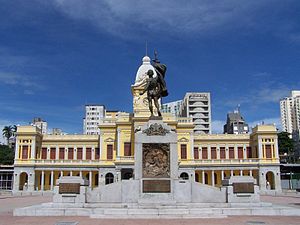
Museu da 2ª Guerra Mundial
| Permanent Exhibits |
 The National World War II Museum, originally founded as the National D-Day Museum, features permanent exhibitions highlighting the nation’s road to war, life on the Home Front and the amphibious landings at Normandy and in the Pacific. The National World War II Museum, originally founded as the National D-Day Museum, features permanent exhibitions highlighting the nation’s road to war, life on the Home Front and the amphibious landings at Normandy and in the Pacific.
|
| Special Exhibits |
 The Discovery Hall Special Exhibit Gallery features changing exhibitions on all aspects of the war to reflect the Museum’s expanded mission. The Discovery Hall Special Exhibit Gallery features changing exhibitions on all aspects of the war to reflect the Museum’s expanded mission.
|
| Online Exhibits |
 Focus On: Saipan and the Marianas Focus On: Saipan and the MarianasChronicles the Marine Corps struggle to capture the Island of Saipan in the Marianas; and the 20th Air Force’s bombing efforts launched from the Marianas against the heart of the Japanese Empire.
|
| Gallery Guides |

Click here to view Museum floor plans & gallery guides, and access printable versions. |
The Battle for Iwo Jima

Even before ground operations to secure the Mariana Islands of Guam, Saipan, and Tinian ended, U.S. Naval construction battalions were already clearing land for air bases suitable for the new B-29 “Superfortresses.” These huge bombers had a range capable of reaching the Japanese home islands. The first B-29 bombing runs began in October 1944. But there was a problem—Japanese fighters taking off from tiny Iwo Jima were intercepting B-29s, as well as attacking the Mariana airfields. The U.S. determined that Iwo Jima must be captured.
U.S. Marines invaded Iwo Jima on February 19, 1945, after months of naval and air bombardment. The Japanese defenders of the island were dug into bunkers deep within the volcanic rocks. Approximately 70,000 U.S. Marines and 18,000 Japanese soldiers took part in the battle. In thirty-six days of fighting on the island, nearly 7,000 U.S. Marines were killed. Another 20,000 were wounded. Marines captured 216 Japanese soldiers; the rest were killed in action. The island was finally declared secured on March 16, 1945. It had been one of the bloodiest battles in Marine Corps history.
After the battle, Iwo Jima served as an emergency landing site for more than 2,200 B-29 bombers, saving the lives of 24,000 U.S. airmen. Securing Iwo Jima prepared the way for the last and largest battle in the Pacific: the invasion of Okinawa.

The flag-raising atop Mt. Suribachi took place on February 23, 1945; five days after the battle began. Associated Press photographer Joe Rosenthal took the famous photograph of five marines and one navy corpsman raising the flag. The flag raisers were Cpl. Harlon Block, Navy Pharmacist’s Mate John Bradley, Cpl. Rene Gagnon, PFC Franklin Sousley, Sgt. Michael Strank, and Cpl. Ira Hayes. Three of these men—Strank, Sousley and Block—were killed before the battle for Iwo Jima was over.
The photograph was quickly wired around the world and reproduced in newspapers across the United States. The image was used as a model for the Marine Memorial at Arlington National Cemetery.
Iwo Jima Oral History: Woody Williams, Medal of Honor Recipient
Woody Williams Medal of Honor citation:
The President of the United States takes pride in presenting the MEDAL OF HONOR to CORPORAL HERSHEL W. WILLIAMS UNITED STATES MARINE CORPS RESERVE for service as set forth in the following CITATION: For conspicuous gallantry and intrepidity at the risk of his life above and beyond the call of duty as Demolition Sergeant serving with the First Battalion, Twenty-First Marines, Third Marine Division, in action against enemy Japanese forces on Iwo Jima, Volcano Island, 23 February 1945. Quick to volunteer his services when our tanks were maneuvering vainly to open a lane for the infantry through the network of reinforced concrete pillboxes, buried mines and black, volcanic sands, Corporal Williams daringly went forward alone to attempt the reduction of devastating machine-gun fire from the unyielding positions. Covered only by four riflemen, he fought desperately for four hours under terrific enemy small-arms fire and repeatedly returned to his own lines to prepare demolition charges and obtain serviced flame throwers, struggling back, frequently to the rear of hostile emplacements, to wipe out one position after another. On one occasion he daringly mounted a pillbox to insert the nozzle of his flame thrower through the air vent, kill the occupants and silence the gun; on another he grimly charged enemy riflemen who attempted to stop him with bayonets and destroyed them with a burst of flame from his weapon. His unyielding determination and extraordinary heroism in the face of ruthless enemy resistance were directly instrumental in neutralizing one of the most fanatically defended Japanese strong points encountered by his regiment and aided in enabling his company to reach its’ objective. Corporal Williams’ aggressive fighting spirit and valiant devotion to duty throughout this fiercely contested action sustain and enhance the highest traditions of the United States Naval Service.














